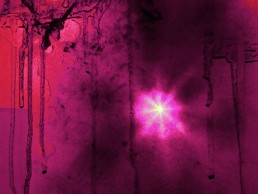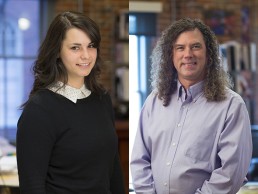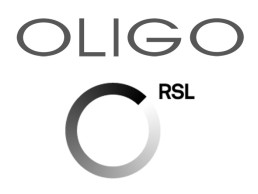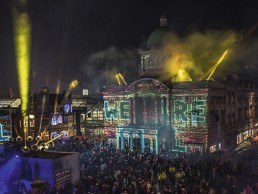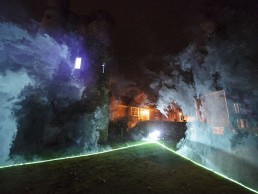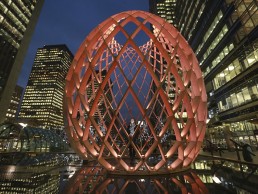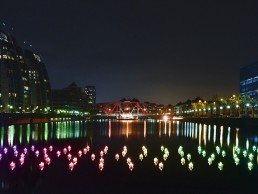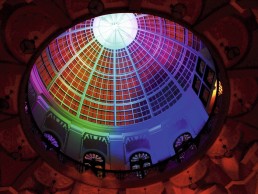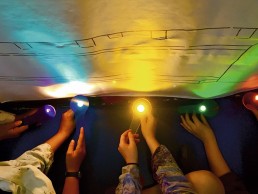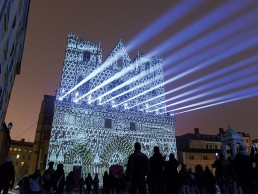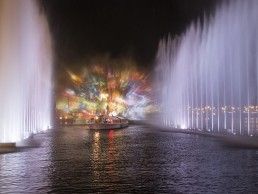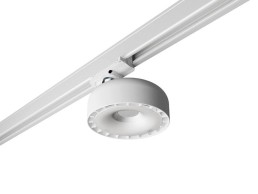BDP lighting team launches Community of Artists
(UK) - BDP lighting team celebrates works from Loop.pH, Haberdashery, Illustrious and Laura Bayliss in new online gallery.
BDP’s lighting team has launched ‘Community of Artists’ an online gallery that showcases several of the artists with whom it shares a special relationship.
Head of lighting Mark Ridler said: “It has been our privilege and pleasure to support a number of artists throughout our many years of practice. Art is becoming increasingly central to our work so partly in recognition and celebration, but also to provide a service to our clients, we have developed our Community of Artists.”
The artists that make up this new online gallery are as follows.
BDP continue to collaborate with Loop.pH, excited by their beautiful work that melds craft, latest technology, ephemerality and architecture and a desire to create art outside the art gallery. They work with designers, architects, scientists in a playful and experimental environment on projects that radically re-think the city.
The team first encountered Haberdashery when pitching for the National Film Theatre and have remained friends ever since with the London based design studio who use the power of light to create landmark sculptures and innovative lighting products for architects, interior designers, brands and institutions globally.
Following years creating electronic music with Heaven 17 and the Human League, Illustrious use 3D sound compositions to create 3D atmospheres and immersive experiences in the urban realm, collaborating with lighting designers, digital and fine artists, world heritage sites, museums, exhibitions, live events, dance, theatre, technology developers, research and education.
Laura Bayliss, an ex-lighting director with BDP is now a practicing artist who paints with light – and lights paint - to celebrate its many characteristics and illustrate the physics of light, such as refraction and dispersion, glow, sparkle and shine.
www.bdp.com/lighting#communityOfArtists
Available Light announces two major staff promotions
(USA) - Derek Barnwell and Rachel Gibney promoted to Principal and Senior Associate respectively.
Available Light has announced the promotion of two staff members: Derek Barnwell, Assoc. IALD from the Raleigh studio to Principal and Rachel Gibney, Assoc. IALD, LC from the NYC studio to Senior Associate.
It’s been two years since Barnwell returned to his Raleigh roots, and in that time, he’s become an integral part of the Triangle design community. His workload is both local, including a major renovation to the library at Wake Forest University, and national, such as the National Museum of the U.S. Army outside Washington DC. As a Principal, Barnwell, a twelve-year veteran at the company, will not only continue to foster client relationships and manage projects; he will more formally participate in setting the direction of Available Light as it enters its second 25 years of serving our clients.
“I’m extremely thrilled to report that Derek’s transition to North Carolina has been a great move for the company, and that is due to Derek’s dedication, hard work, commitment to the local design & construction industry, and sense of humour,” said Steven Rosen, FIALD, Available Light’s President & Creative Director. “We look forward to growing the company below the Mason-Dixon line!”
Gibney, a native Arizonian, first arrived at Available Light as a Designer in 2013. Since joining the studio, she has contributed to the award-winning National Archives Rotunda Renovation, The Museum of the American Revolution, and new Science Research Centers at both Skidmore College and Amherst College.
“I first met Rachel at the Shakespeare Theatre of New Jersey. I was immediately impressed with her rare ability to filter through complex project requirements and, in an instant, cut through the clutter to unleash key design criteria,” said Rosen. “In her tenure at Available Light, Rachel has dedicated herself to lighting the world better and smarter. We are very happy to see her continued success at the company.”
OLIGO buys RSL off Trilux
(Germany) - OLIGO expands field of activity with acquisition of RSL – a new partner for challenging project-focused solutions.
OLIGO Lichttechnik is expanding its portfolio by welcoming aboard another partner, RSL, offering customised luminaires as project-based solutions.
At the beginning of 2017, OLIGO took over the company based in Sankt Augustin, a former member of the Trilux group, further expanding its expertise by multiplying synergy effects within its divisions.
Following this acquisition of RSL, OLIGO’s portfolio now comprises three core business areas: the two existing divisions – one specialising in light-based surface control and colour matching for industrial and auto-motive clients (OLIGO surface controls) and one specialising in premium luminaires for home and business environments (OLIGO Lichttechnik), which have now been complemented by RSL, a brand offering project-manufactured premium luminaires.
OLIGO has now become a one-stop-shop capable of supplying lighting products across the range – be it standard, customised or multi-functional project-based solutions.
With immediate effect, Mr. Thomas Dulas, the CEO and managing director of the two German founding companies of the OLIGO group, i.e. surface controls in Lenzen and OLIGO Lichttechnik in Hennef, is also in charge of affairs at the newly found ROL Lichttechnik in Sankt Augustin.
‘‘Made in Germany’’ will remain the foremost feature of the OLIGO product range. All its divisions and departments design, develop and manufacture in Germany exclusively. With its technology – CNC machines, sheet metal chamfering, wet painting cabins, powder coating – and its test laboratories, RSL complements its business philosophy.
Made in Hull, UK
In 2013 it was announced that Hull would become ‘City of Culture 2017’, the second city in the UK to be awarded City of Culture status. Hull UK City of Culture 2017 was set up by the city's council as an independent company and charitable trust.
Internationally-renowned lighting designer Durham Marenghi was brought in to his hometown to enhance a number of stunning audiovisual installations across Hull as part of the city’s UK City of Culture 2017 inauguration festivities.
Marenghi, who has previously designed lighting for outdoor events such as the London NYE countdown, the Diamond Jubilee Concert at Buckingham Palace and the Rio 2016 Olympic Ceremonies, was assisted in the project by West-end theatre lighting designer and Hull resident Tim Lutkin. Together they specified over 60 Claypaky fixtures, 22 RGB wall washers from UKLED and 64 SGM P-5 washes from Manchester-based lighting specialist DBN lighting to create architectural light shows at the city's historic Queen Victoria square, famous aquarium The Deep - as well as an installation in an underpass famous for secret raves.
“It was crucial for us to keep the open air platform in mind when selecting fixtures; an outdoor environment is always a challenge for the technical aspects of a production,’’ said Marenghi. ‘‘I selected the Claypaky products because they're lightweight very power efficient and compact, making them easy to rig and weatherproof in these difficult environments; the UKLED and SGM fixtures are IP65 so ideal for Hull in Winter.’’
At Victoria Square, Marenghi and Lutkin employed 34 Claypaky Mythos to complement video content by animator and video designer Zsolt Balogh, which was projected onto the façades of Hull City Hall, Ferens Art Gallery and the Maritime Museum. Titled Made in Hull, the film worked with dynamic aerial lighting displays to immerse onlookers in 100 years of the city’s maritime and aviation industry. The design also had LED strip lights, supplied by UK LED in Hull, radiating from the Maritime Museum and City Hall screens during a sequence celebrating Hull Fair, which reached it’s 700th anniversary in 1993.
The searchlight effect of the powerful Mythos also allowed Marenghi to add extra impact to an audiovisual display at The Deep, the UK's landmark centre for marine research, and cast beam effects over the Humber estuary. An animation about the origins and travel of Hull's people by video and projection design house Imitating the Dog was projected onto the building’s striking contemporary architecture, which resembles a shipwreck.
Hull City of Culture will now oversee the 365 days of pledged transformative cultural activity throughout the city in 2017 and judging by the success of the first Made in Hull event the forthcoming events will be a great showcase for the City and its culture.
www.hull2017.co.uk
www.durhamld.com
LewesLight, UK
Taking place October 2016, the second LewesLight Festival built on the success of the previous year, expanding to include a broader team of designers from theatre / opera, music, architecture and art backgrounds, joining the architectural designers who took part in 2015. The festival also expanded its educational component to include STEM workshops in association with the University of Sussex and activities of an environmental focus with the South Down National Park and a local nature reserve. The latter to produce torch installations, an interactive sculpture, night walks and stargazing.
The main festival remained very much the same with a number of installations designed to investigate themes and narratives from local history and reinterpret buildings and spaces in an unexpected way. The installations ranged from prominent landmarks such as the Castle and Priory, through to houses and more prosaic features normally passed by with little thought. Each was intended to work alone or to provide a backdrop for guided historical walks. This year’s designers and artists were as follows: Graham Festenstein, Leora Honeyman, Maggie Lambert, Neil Marsh, the team from Nulty+ working with Karen Van Creveld, Pedro Pinto, Paul Pyant and Eleni Shiarlis.
The theme was: The darker side of Lewes Life, which investigated lesser known stories and historical events with sinister overtones, such as the story of the Lewes Rat - a tale of the body of a mummified rat that can be found in Ann of Cleves House.
LewesLight’s setting has a sensitivity and intimacy that is lost on many other festivals and as a design led event it is keen to retain this. Spectacle, big installations and big crowds are not in its DNA like in big art commission based events.
The festival still has a strong educational focus, not only in terms of promoting the town’s history and the environmental impact of lighting, but also in terms of lighting and urban design, the technical and engineering aspects of lighting and the creative aspects of design, art and photography. To this end it partners with the local Sussex Downs College where the festival is embedded in the Production Arts Course and features in Art and Design and Digital Arts courses, and also with the Lewes Youth Theatre. ‘‘We also work with local schools and community groups and hope to generate a collaboration with Brighton University for this year,’’ commented Graham Festenstein, Festival Director and Independent Lighting Designer. Expanding on the academic theme, the festival held a successful day-long conference discussing ideas around lighting in urban design and festivals, aimed at industry professionals and others with an interest in lighting.
‘‘We hope that LewesLight continues to grow, it still operates on a tiny budget and relies on time and effort provided by its organisers and supporters with a small contribution from the Town Council. In the long term we hope to generate sponsorship from local business, but in the current financial climate we have an uncertain future, however this will not be stopping us from pressing ahead with plans for October 2017,’’ concluded Festenstein.
Winter Lights, UK
January’s dark evenings were illuminated throughout London’s Canary Wharf by angels, glowing graffiti and floating poetry, revealed by state-of-the-art light technology. These formed part of the free Winter Lights exhibition, which opened on 16 January 2017.
For the third year running, Winter Lights brought spectacular artworks, installations and experiences to Canary Wharf, many of them interactive or responsive. As a collection, the 30 pieces showcased works by some of the most inventive and exciting international artists working with Light Art today.
Visual Arts curators of Canary Wharf Group plc, Keith Watson and Sally Williams said: “This year’s amazing Winter Lights festival was our best yet, surpassing last year’s spectacular award-winning offer. The roster of artists we attracted this year are some of the most imaginative creators working in the field today.”
Some of the pieces on show – Angels of Freedom, Luma Paint, OVO (OVO Collective), Horizontal Interference, Digital Skin, Nonotak, Origin and Water Wall – had never been exhibited in the UK before, making this year a truly unique experience for visitors.
Angels of Freedom, by Merav Etan and Gaston Zahr, contained a deep underlying message discouraging discrimination through interaction. Five giant wings with white halos invited people to turn into angels in a few simple steps through the power of photography social media.
OVO (OVO Collective) immersed visitors in unique and beautiful light structures whilst Marcus Lyall’s On Your Wavelength was a mind-powered laser and sound installation of over 20,000 LEDs. Lyall’s structure used participant’s brain activity to choreograph beautiful light patterns.
Visitors were invited to put their painting skills to the test in Mateo Mounier’s Digital Skin, creating compositions of bright colour and pattern. Meanwhile over the weekend of 20 –22 January, live graffiti crafted from light was on show with Luma Paint Light Graffiti (Lichtfaktor feat. Helge Bomber Steinmann), transforming any object in to a live painting canvas. Bringing a further element to the fore, Water Wall (Gregory St. Pierre) used a mist screen to interact with visitors as they created beautiful patterns on to a wall of water.
For contemplation, The Garden of Floating Words by Elisa Artesero evoked a peaceful note, giving the impression that a cluster of glowing neon words floated in the foliage of Jubilee Park, creating a poem of transience. BLOOM (Squidsoup) also had a calming effect made up of a thousand spheres of light each bobbing gently in the wind. One piece drew attention to world issues, created by Mike Stephen and school children, Liter of Light, which highlighted the need to give light to undeveloped countries.
In conjunction with the Winter Lights festival 2017, an exhibition by artist Lillian Lijn featuring spectacular sculptural works using light will be on display in the lobby of One Canada Square from 8 January to 17 March 2017.
Winter Lights Festival 2017 was free to the public and could be seen across the Canary Wharf Estate from 16–27 January 2017.
www.canarywharf.com/arts-events/events/winter-lights-2017/
Lightwaves, UK
Quays Culture recently launched the UK’s biggest digital light festival, Lightwaves, which took place in December last year. The festival brought light to the dark winter nights, as nine free light experiences spanned across The Quays in Manchester, from the Plaza between The Lowry and the Lowry Outlet, to MediaCityUK’s Piazza, and even illuminating the River Irwell.
The festival featured new and exclusively commissioned digital art displays alongside emerging talent, light workshops, and illuminations - from local, national, and international artists.
“People will love that this ten-day, annual, free event brings unexpected and beautiful artworks into outdoor spaces,’’ said Lucy Dusgate, Programme Producer at Quays Culture. “Central to each year is a new large-scale art commission, ensuring Salford is home to the best in innovative art creation. This year, we have everything from a large heart that illuminates when you hold hands, to 198 small, floating boats strung across the water whose rainbow of colours you can change with your mobile phone. Two years ago, we started off with just one artwork, and have grown to showing nine, including some fun historic ones from the infamous Blackpool Illuminations collection. Each year, we commission a brand-new digital sculpture for the Lowry Plaza outside The Lowry Theatre. All of the artworks we show come from artists who use digital in their work, so the art can be as intriguing as it can be inspiring.”
A brand new, large-scale commission, specifically for Quays Culture, is Heart Beat, the brainchild of artists and installation specialists, GNI Projects, who used Radiant Lighting following their collaboration at darc night. A co-commission with Blackpool Illuminations, Heart Beat is part of the GNI Project’s ‘Light Love Collection’ - a series of art installations using mixed lighting media to create the symbol of a heart. From one angle Heart Beat is an animated 3D heartbeat pulsing through the sculpture. From another angle, the lights join to form a heart. For the heart to appear spectators are encouraged to make a connection of love, or friendship, by joining hands in front of the sculpture; human touch reveals the heart. Once the connection is lost the heart is broken into fragments again.
Created by Aether & Hemera – a multi-disciplinary art and design studio, producing contemporary lighting art and interaction design - Voyage features six lines of 33 origami boats, occupying a space of 630m2 - the 198 boats were designed to engage with the community and transform the waterfront. The fleet composes an organic matrix of interactive lights, which change colour when passers by interact with it on their mobile phones. The public can transform the pattern and colour of the paper boats by connecting their mobile device to Voyage Wi-Fi network and opening their browser to access Voyage.co.uk; users are given a choice of artworks to interact with, such as a rainbow or the night sky – choosing an artwork option to change the colour of the boats in the water.
This year, Quays Culture collaborated with lighting legends of the North, Blackpool Illuminations. Quays Culture is currently showcasing items from Blackpool’s light collection, which reflect the location of MediaCityUK, home to the BBC, including Dr.Who Daleks, The Tardis, and Spacemen. The collection also features iconic children’s characters, including Noddy, Postman Pat and SpongeBob, along with a forest of LED trees.
An emerging talent programme, SHINE, in partnership with Leeds Light Night, has seen the creation of three new commissions, from up-and-coming artists. Footsteps, by Sam Sebbage, consists of 80 illuminated footsteps walking a path. Each footstep is created from artificial grass and embedded with lights; representing the path each of us walks. Edyta Masior is the artist behind Laiki#5 – fluorescent fishing lines are suspended within a structure and fitted with contact microphones. This interactive installation creates air vibrations, when the strings are plucked, creating sound, like that of a harp. Fireflies, a creation from Fixed Grinn Collective, is a series of floating illuminations, which interact with their surroundings as they ‘fly’ amongst those that visit them. Consisting of hundreds of illuminated LED spheres that seamlessly float, the installation interacts with the public as its fire-like embers swirl; forming a connection, which is organic, yet synthesised, mechanic, yet fluid.
Today I Love You, created by Massimo Uberti & Marco Pollice, was commissioned for Amsterdam’s Light Festival 2015. Italian artist, Uberti is known for his poetic light installations; he wrote out this simple sentence in light, so that the words become matter and, more importantly, the uplifting words are repeatedly enjoyed. This presentation marks the start of a partnership between Quays Culture and Amsterdam Light Festival.
Lightwaves 2016 was made possible by funding from Arts Council England and AGMA, and support from The Quays, The Lowry, Peel | MediaCityUK and Salford City Council.
Quays Culture is a member of Lighting Up the North, a network of light festivals taking place in seven cities across the North of England.
#Lightwaves2016
Lightpool, UK
Over 50,000 people attended the LightPool Festival from October 28 to November 2 2016 in Blackpool. The newest light art festival in North England (and newest Light Up The North network member), it celebrated last year’s Blackpool Illuminations, the world’s oldest, free light show.
In 2014, The Coastal Communities Fund invested £2million into Blackpool over two years with the aim to create sustainable growth through cultural innovation. Building on the love for the Illuminations, LightPool developed a creative vision for the 105-year old show. Reconnecting The Lights with the people of Blackpool is a key part to this, and with additional support from Arts Council England, LightPool brought together the strands of the two-year programme into a free celebration of light, art and fire.
“There is nothing quite like Blackpool Illuminations in terms of scale,” said Alex Rinsler, Creative Lead and Festival Director. “Over many years the Illuminations have played with light and lighting technologies to create a magical experience for people to enjoy. The LightPool Festival offered the opportunity to make work in the place where The Lights began.”
35 light installations included 21 new commissions, six large-scale productions, five giant projection shows on Blackpool Tower, on-going community and engagement work and a conference. Installations were curated to appeal to a wide range of audiences, and to celebrate the diversity of light technologies with 2D, 3D, durational and interactive works. From a rusted Punch and Judy booth playing a fifteen-minute projection (Salvage Sideshow by Hannah Fox), to a colour wheel of light transforming the Winter Gardens’ iconic dome (Round Gradient Remix by Liz West, in partnership with Lumenpulse), or a ghostly figure haunting a lonely bench on Blackpool’s promenade (I Waited by Elisa Artesero), the festival opened up the town in unusual ways.
A scientific piece, Brain Container by Jo Berry, illuminates a series of digital design drawings from a range of neuroimages from Dr. Lena Palaniyappan’s research to create images for a thoughtprovoking installation.
The display is accompanied by music by composer Angela Slater, having designed the sound in response to imagery found in Berry’s studio.
Activist and light art pioneer Yoko Ono offered two works created 50 years apart: Parts of a Light House and Imagine Peace. Parts of a Light House – 60 delicate glass prisms refracted light in response to Ono’s original script from 1965, describing the lighthouse as ‘a phantom house that is built by sheer light’. The work illuminated the altar of Blackpool’s Sacred Heart Church, well-known for its unusual octagonal roof. Secluded in a chapel to one side, was Michael Trainor’s Goodbye Coco, a coffin for a fictional clown, bedecked in 540 fairground lights.
Turner-prize nominee Mark Titchner created two projected works that referenced ‘Progress’: Blackpool’s borough motto. Plenty and Progress, inspired by Claudegen’s 1930s neon designs, to illuminate Blackpool Town Hall - a symbol for development and prosperity. Nearby, What use is life without progress? reflected unreasonable pressures for self-improvement, a giant gobo projection not out of place on Blackpool’s promenade.
The LightPool project has enabled the town to come together around light: The Grundy Art Gallery hosted NEON: The Charged Line, which attracted a record number of visitors and received national coverage, including iconic works from Tracey Emin and David Batchelor. Works from the show spilled out of the gallery, including Let’s Pretend This Never Happened by Tim Etchells, positioned on the roof of the building.
Also of note was Art Is Your Human Right: five illuminated signs from Bob & Roberta Smith, manufactured at the Illumination’s depot. They create a visual trail and work to challenge perceptions of public space. It appealed to the artist that the signs would need to be cared for and maintained over time, just like our own human rights.
“Producing a light art festival in Blackpool presents its own challenges,” added Rinsler. “The town is already bathed in flashing lights. We encouraged artists to play with what is already here – not to compete with it. Local ownership is vital to its success in the long-term, so events like Lumidogs (a mass illuminated doggy fashion show) are just as important as strategic partnerships with makers and innovators like Lumenpulse, or presenting work from some of the world’s most important light artists.”
The aim is to develop the event as a biennial, showcasing the best of light and fire-based performance, as well as visual arts. “Blackpool’s history with light and with entertainment sets it apart from other places. It’s a gap in the cultural landscape that fits Blackpool’s personality and history,” concluded Rinsler.
www.illuminations.visitblackpool.com/#lightpool
illuminating York, UK
Students from York College, Fulford School, St Wilfrid's RC Primary School and The Mount School took part in Society of Light and Lighting (SLL) workshops at illuminating York in October 2016.
Their designs were used by the SLL to show four famous York landmarks in a new light.
Their resulting designs were then put before a panel of judges, with the winners used to illuminate St Leonard’s Hospital, St Michael-Le-Belfrey, Exhibition Square and the Multangular Tower in the city’s Museum Gardens.
Created by the SLL, the workshops - called Pockets of Light - saw the society visit each school to demonstrate the science behind lighting and its potential to create artistic designs. The workshops also looked to help the students re-think places in their own city, which could be transformed using creative lighting design.
The displays were part of the SLL’s contribution to the illuminating York festival, during which landmarks around the city are lit by artistic lighting designers, including: Light Masonry by Jason Bruges Studio at York Minster; Lumenpulse at the Royal York Hotel; Lumenpulse at Clifford’s Tower; Travelling Light by Heinrich & Palmer at the National Railway Museum; Lumen by David Ogle at York St John University; re Connecting re Creation by Helen Maurer at Holy Trinity Church; Loopy Lou by Rémi Brun at King’s Square; and Orbit by Studio PSK at Shambles.
Alexandra Cornel Atkinson, a second year student on a production arts programme at York College who attended the workshop ‘Introduction to architectural lighting’, said: “I found the workshop interesting, learning about how architectural lighting has similarities to theatrical lighting, also the use of additive colour mixing with red, green and blue LEDs and white LEDs and the way they produce wonderful subtle hues that I will continue to use on other installations and productions.”
Jane Conway, Head Teacher of St Wilfrids, added: ‘‘St Wilfrid's was delighted to take part in the illuminating York project. The challenge of designing a light display for a section of the city walls not only captured the imagination of our Year 6s, it also gave them an exciting, hands-on science experience to remember.’’
Dan Bodey, Deputy Head of Fulford School, said: “This was a fantastic activity that engaged and inspired our students. The chance to learn new skills, rooted in such a high profile in our city was a real opportunity.”
Jeff Shaw, President of the SLL, concluded: “We are delighted to have had the opportunity to work with students to create these spectacular designs for illuminating York, and also to have had the opportunity to demonstrate the exciting potential of light as an art and a science. The students’ designs were fantastic, and I’d like to congratulate them on their hard work.”
The students’ work was visible as part of illuminating York from 26th – 29th of October.
Lyon Fête des Lumières, France
Words by Graham Festenstein, Lighting Designer and organiser of LewesLight.
Lyon’s Festival of Light takes place around the 8th December each year and, as the grandmother of all lighting festivals, has been running in its current form for almost twenty years.
As someone who has routinely advocated the benefits of lighting festivals from both a social and economic perspective, and also as I have recently been organising a festival of my own, I took a trip to Lyon to see first hand how an event with such a great pedigree is delivered.
Lyon is not a small city, located at the meeting of two rivers and partially on a hill it has beautiful buildings and an interesting and long history. From a lighting perspective it has an important history as well, as Lyon was the first city to develop an integrated lighting strategy back in the late 1980s.
The festival has now grown to grand proportions, attracting around four million people each year. Following security fears after the events in Nice and Paris, this year’s festival was reduced to only three days and was more contained within the historic city centre than in recent years, however it still took two long nights from 6PM until midnight to experience all that was on offer.
The range of installations was diverse in terms of content, style and concept, there was a high representation of video mapping installations and, not surprisingly for France, many installations were accompanied with a soundtrack Son et Lumiere style. Some installations were clearly intended for families with young children whilst others were more cerebral and demanding. Almost all of the installations were dynamic in some way both in terms of movement and colour. Of the 35 primary installations several stood out for me as being especially successful. Those that know me and my sometimes conservative approach to design might be surprised but my favourite was Benedetto Bufalino and Benoît Deselle’s La Bétonnière Boule à facettes, a cement mixer converted to a giant rotating mirror ball, lighting up the surrounding buildings accompanied by ’90’s disco hits. A close second was Yann Nguema and EZ3kiel’s installation Evolutions on the Saint-Jean Cathedral, possibly the best video mapping I have experienced and even more impressive when you consider that Yann is foremost a musician who apparently has only been working with video for a couple of years. Another great video installation was Voyage by Camille Gross and Leslie Epsztein, projected onto the Gare Saint-Paul it was a temporal journey through the station’s history and into the future.
Not that many of the installations were actually site specific and / or inspired by the context of their location, which I found a little disappointing, although when a festival gets to this size and popularity it is difficult to know if this really matters as the average visitor will be content with the spectacle, drama and scale of the event. It is also worth noting that the city looks to deliver an event for all of its inhabitants and not just those with sometimes pedantic attitudes to art and design. Personally I prefer a more considered approach, providing a more contemplative and interpretive experience that draws reference in some way to the context of the place. Lyon did achieve this with the installation Candles from the Heart in the Théâtre Antiques de Fourvière. Despite the number of people, these amazing spaces lit by approximately 20,000 candles provided a calm and contemplative space and a little respite from the crowds and bright lights further down the hill. The other nice aspect to these pieces was the element of surprise and the unexpected arriving in a calm and relatively quite space, which was welcome and refreshing in many ways, taking the breath away more successfully than the big bright and dynamic pieces elsewhere. In addition, this piece, which is repeated in different ways and locations each year, raises money by donations from visitors for each candle which are distributed by the charity Electriciens Sans Frontières promoting access to electricity to destitute populations.
Other installations I particularly enjoyed were Caprice by Sebastien Lefèvre on the banks of the Rhône, comprising four dynamic towers, swirling vortexes of light driven by the power of the river itself. A small interactive installation popular with families and young children was Step Up! by Nicolas Galland and Julien Lafosse. Platonium by Éric Michel and Akari-Lisa Ishii is a collaboration between artist and scientist using an exciting self illuminated fabric strip and Roboticum by Yves Moreaux, a fun installation using large LED panels articulated by industrial robots – an example of how the festival works with local industry.
I had a good time in Lyon; it is a big, slick and professionally delivered event that caters for many diverse people and does wonders for Lyon’s tourism and reputation. At that it succeeds perfectly and is a great festival.
Amsterdam Light Festival, Netherlands
Every edition, Amsterdam Light Festival artworks are selected by a jury through a Call for Concepts, where international artists are asked to submit new ideas.
The 2016/17 festival consisted of two different routes. Water Colors, the boat route, took place in the canals of Amsterdam and let visitors experience the artworks from a water perspective. Illuminade, the walking route, exhibited artworks and installations in the Plantage neighbourhood.
Every year, the festival introduces a new theme which the artists base their work on. For the this year’s Water Colors theme,
artists were challenged to give a new view on the city and its architecture, future and role in the world. Amsterdam serves as a canvas for new art and light installations that are connected to specific characteristics of the city. The theme was interpreted by the artists in their own way, sometimes historic, futuristic or with humour and irony. The artworks offerered new perspectives to the visitors and raised questions about the city.
Secondly, the Illuminade route focused on a theme of biomimicry - the science of the logic and structures of nature being applied to solve human problems. Think of energy efficient buildings inspired by termite mounds or antibacterial surfaces inspired by red seaweed. The artworks that were selected engaged in a dialogue based on all aspects of the biomimicry theme.
www.amsterdamlightfestival.com
Water Colors Installations:
Ana Morphè – Isabel Nielen, Together – Luigi Console & Valentina Novembre, Bridge of the Rainbow – Gilbert Moity, Blueprint – Reier Pos, Bunch of Tulips - Peter Koros, Nexus – Victor Viscek, ARCO – Teresa Mar, What’s he building in there – Laurent de Wolf, A Window in Time – Motion Paintings, Nest – Vikas Patil & Santosh Gunjar, WISP - Pitaya, The Lace – Choi+Shine Architects, Wolfert’s Dog – Tatiana Titova, 15000 and more – Studio Klus, Rhizome House – DPArchitects, Lightwaves – Benthem Crouwel Architects, Eye_Beacon – UNStudio, Flower Strip - Aether & Hemera, Welcome to my (home)town - Lighting Design Academy, Souvenir – Erik Kessels.
Illuminade Installations:
Mens - Human - Edson Bruno Filho, Green House – Victor Engbers, Mini-Biomimimcry - Stichting Schoolbuurtwerk and eight Amsterdam primary schools, Nerve - member Lydia Fraaije, SONAR Light Pulse - Paul Cremers, Rotifers - Nicole Anona Banowetz, Under Influence - Iemke van Dijk, GREEN PIGS - BIBI, Enthalpy - John Bell, Hourglass - Wilhelmusvlug, You Lookin’ at Me? - Tropisme Art & Science Collective, Flowering Phantasm - Clay Dorse Odom, Human Beeing - The Constitute, Dancing with Trees - Reanna Niceforo and Phil Sutherland, Living Pods - Anouk Wipprecht, Tree Hugger - Daan van Hasselt and Asia Jackowska, Translucent - HvA and Breiter Aademy, From Twente with Love - Randy van Lingen and Vanessa Evers.
3F Filippi 3F Emilio
Small and handy, 3F Emilio is a new spotlight for indoor environments. Conceived by belgian designers Serge and Robert Cornelissen, it is the ideal choice to illuminate retail areas and offices, thanks to its strong thermal performance and high visual comfort. It includes a compact LED module of CCT nominal colour temperatures 2,700K, 3,000K or 4,000K, with a colour rendering index of CRI >80 or >90. Also, it offers compact LED modules / MEAT (version for meats), / BREAD (version for bakery) and / CRISP (version for wardrobe with white enhancement).


